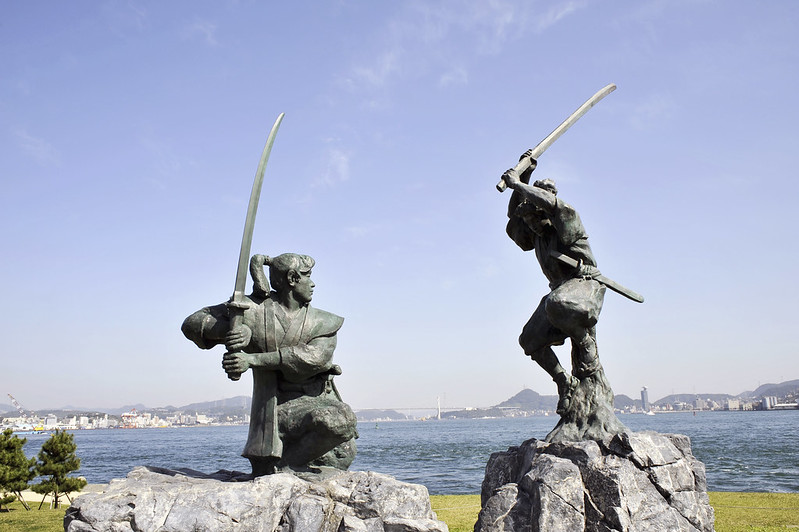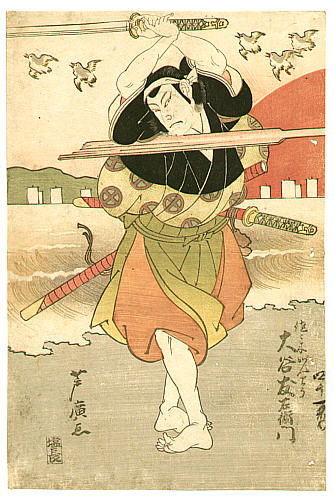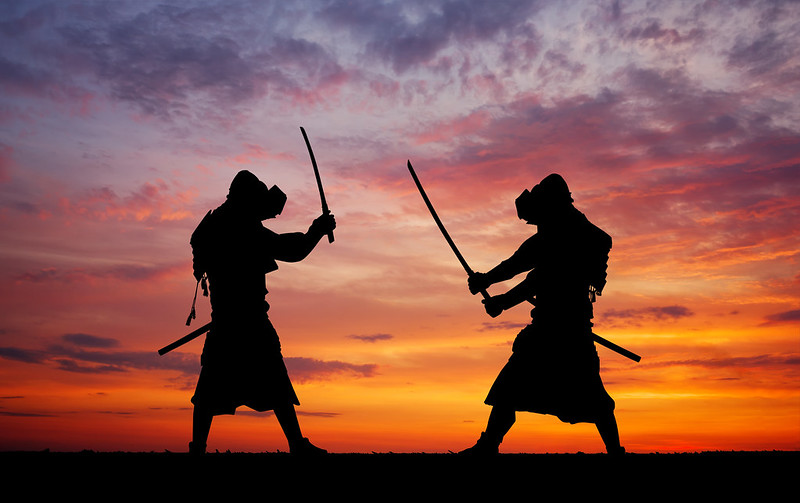
The Duel Between Sasaki Kojirō and Miyamoto Musashi
Sasaki Kojirō (佐々木 小次郎, 1585–1612), of Fukui Prefecture, Japan, was also known as Ganryū, or Large Rock style. Kojirō was a master swordsman during the Sengoku and early Edo periods. He studied Chujō-ryū (old style martial arts founded in the 14th century by Chujō Nagahide) sword fighting from either sword masters Kanemaki Jisai or Toda Seigen. Kojirō later went on his own and founded the Japanese traditional school for swordsmanship, Ganryū, the name he is also known for. He is also known for his skills in wielding the nodachi (a long traditional Japanese sword) known as the Drying Pole and the Tsubame Gaeshi technique (Turning Swallow Cut) believed to mimic the motion of a swallow’s tail during flight. 
The Duel Monument Of Ganryu Island.
 Miyamoto Musashi (宮本 武蔵, 1584–1645) is also known by his other names, Shinmen Takezō or Miyamoto Bennosuke, or his Buddhist name Niten Dōraku. He was an expert swordsman and rōnin who was known for his many duels even when he was very young. Miyamoto Musashi was the author of The Book of Five Rings, about tactics, strategy, and swordfighting philosophies that are still used today. He also founded the Hyōhō Niten Ichi-ryū or Niten-ryū style popular for its two-sword techniques.
Miyamoto Musashi (宮本 武蔵, 1584–1645) is also known by his other names, Shinmen Takezō or Miyamoto Bennosuke, or his Buddhist name Niten Dōraku. He was an expert swordsman and rōnin who was known for his many duels even when he was very young. Miyamoto Musashi was the author of The Book of Five Rings, about tactics, strategy, and swordfighting philosophies that are still used today. He also founded the Hyōhō Niten Ichi-ryū or Niten-ryū style popular for its two-sword techniques.
Miyamoto Musashi illustration.
Sasaki Kojirō and Miyamoto Musashi were involved in one of Japan’s historic duels in 1612. The two swordsmen were bitter rivals at the time. There are several accounts on the story that led to the actual duel; the one considered the most accurate goes like this.
 Miyamoto Musashi, wishing to put an end to the notion of who is really the best swordsman, requested Lord Hosokawa Tadaoki (a respected samurai), through his trusted vassal Nagaoka Sado Okinaga, to arrange a duel between the two swordsmen. The duel took place on 13th April 1612, in the remote island of Ganryujima of Funashima, off the coast of the Bizen Province. As part of a strategy to throw off Kojirō ‘s inner state of being, Musashi arrived three hours late.
Miyamoto Musashi, wishing to put an end to the notion of who is really the best swordsman, requested Lord Hosokawa Tadaoki (a respected samurai), through his trusted vassal Nagaoka Sado Okinaga, to arrange a duel between the two swordsmen. The duel took place on 13th April 1612, in the remote island of Ganryujima of Funashima, off the coast of the Bizen Province. As part of a strategy to throw off Kojirō ‘s inner state of being, Musashi arrived three hours late.
When he finally arrived, the officials of the duel as well as Sasaki Kojiro were extremely irritated; Kojiro was full of rage. On drawing his katana, he threw his scabbard aside, prompting Musashi to further enrage him by commenting, “If you have no more use for your sheath, you are already dead.”
The duel began with both men on guard as a show of respect for the other’s skill with their own style and technique. In the end, though, there could be only one winner. Musashi had provoked Kojirō to make the first attack. Miyamoto quickly countered and succeeded in breaking Kojirō’s left ribs and puncturing his lungs, eventually killing him. Because of this event, Musashi attained spiritual awakening and renounced ever doing lethal duels in the future.
